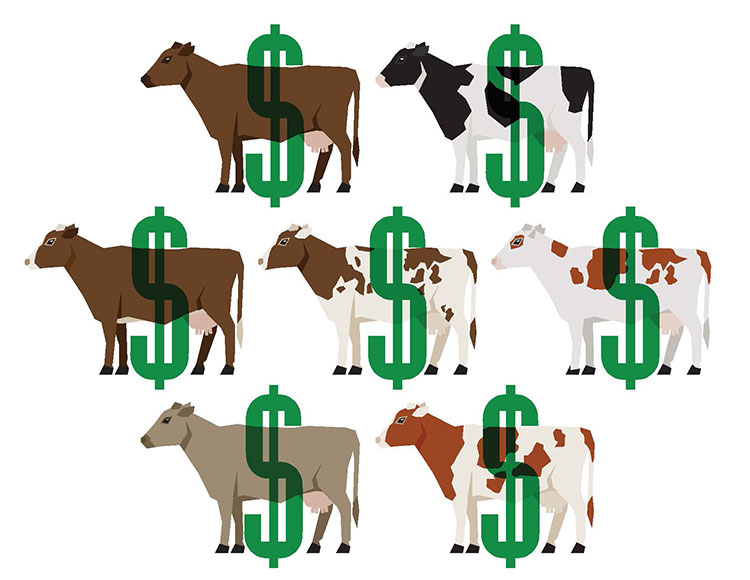
Each and every replacement heifer and the resulting cull cow come with a cost. Net herd replacement cost (NHRC) is one way to calculate the value of animals leaving your herd (cull, dairy sale, or death) less any revenue received for those animals removed. NHRC held steady at $1.33 per hundredweight (cwt.) for both 2016 and 2017 after rising from 2015 levels of 98 cents per cwt.
The top 25 percent of clients had a NHRC of $1.16 per cwt. due to generating slightly more value for cull cows, culling less, and having less death loss. Operations should target a value of a $1.50 per cwt. or less. However, a common thread among elite producers is net herd replacement costs closer to $1.15 per cwt.
The potential ways to lowering NHRC are:
1. Cull animals when they are at their prime level for generating cull value.
2. Manage heifer inventories to adequately supply replacement needs of the dairy, without artificially inflating the replacement rate of the herd.
3. Drive down death loss to a target of 5 percent or less.
Capital costs also were up for 2017, with the benchmark average climbing 17 cents to $2.71 per cwt. Capital costs are made up of three things: depreciation, interest, and leases. This cost has risen nearly 40 cents per cwt. over the last three years.
From a depreciation level, the value used in our benchmark report is management level depreciation and not at the tax level. However, the inflation in the benchmark number is not coming from as much on the depreciation side as it is coming from interest. As the average herds in our benchmark have taken on losses and needed to borrow funds in order to finance operations, the amount of interest expense has gone up as well. With greater borrowing compounded with growing interest rates, capital costs continue to rise and are more difficult to lower unless earnings are turned around.
Balance sheet impact
With the income statement linked to the balance sheet, profits and losses have had varying impacts on balance sheets over the last few years. With a third year of losses, the average balance sheets have lost 7 percent equity since 2014.
Working capital current assets (cash, feed inventory, accounts receivable) less current liabilities (accounts payable, current portion, operating loans) has dropped from $1,287 per cow to $346 per cow at the end of 2017. Working capital is critical to the liquidity of a farming operation and its ability to pay bills and service debt.
These two measures give a straightforward overview of how your business is set up for the long term and for the immediate future. A standard target for owner equity (net worth per assets) would be 55 to 60 percent for a steady-state operation, but can dip to 45 to 50 percent in growth stages. Ideally, you don’t want your lender to own more of your business than you do.
To evaluate how well your business is structured for the near future, target a working capital per cow level of at least $600. This helps ensure you have the cash available to maintain cash flow and also take advantage of prepayments, cash discounts, or unexpected capital purchases that can improve your operation’s efficiencies.
These two items can also offset each other — if your operation is in a comfortable owner equity position, it can withstand erosion in working capital and earnings. Conversely, a strong working capital position can insulate owner equity against deterioration in down markets.
Seven bright spots
Despite the detrimental effects of the sagging milk prices on the dairy industry, a few bright spots can be found in the review of the 2017 benchmarks. There are several key items many of the top producers achieved in 2017 that allowed them to be successful.
1. Take advantage of improved income over feed costs (IOFC) potential by driving dry matter intakes, maximizing milk production to achieve 6.25 pounds of butterfat and protein combined per cow per day, and targeting IOFC over $8.50 per cow per day.
2. Spend time with employees re-evaluating procedures and protocols to maintain consistency and maximize performance of labor.
3. Evaluate your culling program and target less than $1.50 per cwt. net herd replacement cost.
4. Maintain a strong working capital position so you can take advantage of opportunities that arise. However, excess feed inventories can inflate working capital and can actually be a detriment to your operation. If you are maintaining a year’s worth of feed carryover, consider selling some feed inventory, planting more acres into cash crops, or renting out land to improve cash inflow and reduce outflow for crop inputs.
5. Consider developing and sticking to a milk marketing plan that will allow you to protect yourself from the lows, but still take advantage of market rallies whenever possible.
6. Maintain and consistently review your financial records. Many dairy producers in the top 25 percent regularly designate time to review financial records, evaluate performance goals, and meet regularly with their team and advisers to assess opportunities and areas for improvement.
7. Lastly, benchmarking does not answer every question nor does it provide immediate solutions. It does provide a spark for conversation about how to improve margins and a quest for understanding one’s own numbers better.
Using this benchmark comparison, scrutinize your financials to determine key areas where you can create efficiencies and maximize opportunities for profitability on your operation. Minor adjustments can have substantial effects, including putting your dairy into the top 25 percent.





